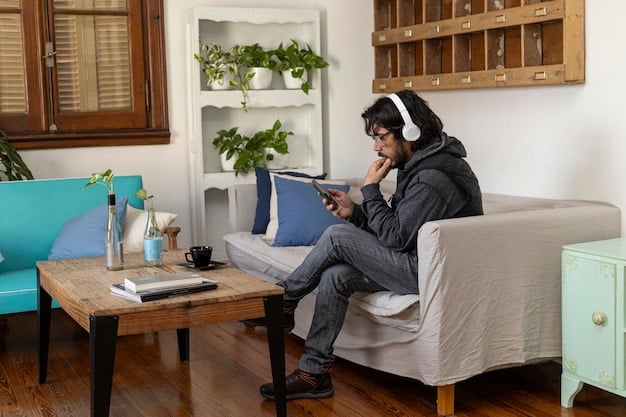Boost Your Home Office with Mindfulness: Stress Reduction & Productivity

The Power of Mindfulness can transform your home office by significantly reducing stress and boosting productivity through simple, effective techniques.
Working from home can be a double-edged sword. While it offers flexibility and comfort, it can also lead to increased stress and decreased productivity. But what if there was a way to harness the power of your mind to create a more focused and peaceful work environment? Welcome to the world of mindfulness, a practice that can revolutionize how you approach your home office, reducing stress and enhancing your overall productivity.
Unlocking the Benefits of Mindfulness in Your Workspace
Mindfulness, at its core, is about being present in the moment, fully engaged with whatever you’re doing, without judgment. Applying this concept to your home office can yield incredible benefits. Imagine a workday where you’re less reactive to interruptions, more focused on your tasks, and less stressed by deadlines. That’s the potential of mindfulness.
Understanding the multifaceted benefits of mindfulness is crucial for crafting a more focused and serene workspace. Introducing mindfulness exercises can bring profound changes to your productivity and overall well-being in the home office.
Stress Reduction
Mindfulness techniques can significantly lower stress levels. By focusing on the present moment, you reduce anxiety about the future or regrets about the past.
Increased Focus
A mindful approach helps you stay present and focused on the task at hand, improving concentration and decreasing distractions.

- Practice daily meditation: Even 5-10 minutes can make a difference.
- Take mindful breaks: Step away from your screen and focus on your breath.
- Engage in mindful movement: Gentle stretching or yoga can help release tension.
Implementing these practices can transform your home office into a sanctuary of productivity and calm.
Creating a Mindful Home Office Environment
Your physical workspace plays a significant role in your mental state. A cluttered, disorganized office can lead to a cluttered, disorganized mind. Creating a mindful environment involves decluttering, incorporating natural elements, and setting up a space that promotes focus and calmness.
The establishment of a mindful workspace goes beyond mere aesthetics. It’s about aligning your environment to foster mental clarity and reduce daily stressors.
Declutter Your Space
A clean and organized workspace promotes a clear and focused mind. Remove unnecessary items and organize your desk regularly.
Incorporate Natural Elements
Plants, natural light, and calming colors can create a more peaceful and inviting atmosphere.
- Add indoor plants: They purify the air and bring a touch of nature indoors.
- Optimize natural light: Position your desk near a window to benefit from sunlight.
- Choose calming colors: Opt for soft blues, greens, or neutral tones for your walls and decor.
By curating your workspace with intention, you facilitate a more mindful and productive workflow.
Mindful Techniques for Managing Distractions
Distractions are a major productivity killer in the home office. Whether it’s family members, social media notifications, or household chores, managing distractions is crucial for maintaining focus. Mindfulness techniques can help you become more aware of these distractions and develop strategies to minimize their impact.
To master the art of managing distractions is invaluable for any home office professional. Integrating mindfulness can provide the mental tools to remain steadfast amidst chaos.
Identify Your Distractions
Start by acknowledging the common interruptions you face each day.
Practice Mindful Awareness
When a distraction arises, notice it without judgment. Acknowledge its presence and then gently redirect your attention back to your work.

- Set boundaries: Communicate your work hours to family members.
- Use technology wisely: Turn off unnecessary notifications and use website blockers.
- Create a dedicated workspace: Having a separate area for work can help minimize distractions.
These techniques cultivate a stronger ability to remain present and engaged with the task at hand, fostering greater efficiency.
Using Mindfulness to Improve Time Management
Time management is another common challenge for home office workers. Procrastination, poor planning, and inefficient task management can lead to stress and burnout. Mindfulness can help you become more aware of how you spend your time and make conscious choices about how to allocate it.
Improving time management through mindfulness is about intentionality and awareness. When you’re conscious of how you allocate your time, you can better manage your workload.
Prioritize Mindfully
Take a few moments each morning to assess your tasks and identify what truly needs your attention.
Practice the Pomodoro Technique Mindfully
Work in focused 25-minute intervals, followed by a 5-minute break. During your breaks, practice mindfulness by focusing on your breath or engaging in a quick meditation.
Integrating mindfulness into time management enhances productivity and decreases work-related anxiety.
Mindfulness and Self-Care in the Home Office
Working from home can blur the lines between work and personal life, making it essential to prioritize self-care. Mindfulness can help you become more attuned to your body’s needs and take proactive steps to prevent burnout. Incorporating mindful breaks, practicing gratitude, and setting clear boundaries are all essential for maintaining your well-being.
When prioritizing self-care, it’s about ensuring your well-being doesn’t take a backseat amidst the hustle of work. Mindfulness practices can anchor your self-care efforts and ensure their efficacy.
Using mindfulness techniques for breaks:
These breaks include short sessions of meditation, stretches, or simply focusing on breathing deeply.
- Take mindful breaks: Step away from your computer and engage in activities that nourish your mind and body.
- Practice gratitude: Start or end your day by reflecting on things you’re grateful for.
- Set clear boundaries: Establish specific work hours and stick to them as much as possible.
Integrating self-care into your work day fosters a healthier relationship with your job and improves overall life satisfaction
Overcoming Challenges and Maintaining a Mindful Practice
Developing a consistent mindfulness practice takes time and effort. There will be days when you struggle to stay present or when distractions seem overwhelming. The key is to approach these challenges with patience and self-compassion. Remember that mindfulness is a continuous journey, not a destination. Embrace the process, and celebrate your progress along the way.
Persistence is key when integrating mindfulness into your daily routine. Overcoming challenges with patience and understanding significantly boosts the effectiveness of mindfulness in your home office setting.
Be Patient with Yourself
Mindfulness is a skill that requires practice. Don’t get discouraged if you struggle at first.
Find an Accountability Partner
Having someone to share your journey with can provide support and motivation.
- Join a mindfulness group: Connect with others who are practicing mindfulness.
- Seek professional guidance: A therapist or mindfulness coach can offer personalized support.
Consistently practicing will further cement the benefits mindfulness provides.
| Key Point | Brief Description |
|---|---|
| 🧘 Stress Reduction | Mindfulness techniques lower stress and anxiety. |
| 🧠 Focus Improvement | Mindfulness enhances concentration and reduces distractions. |
| ⏰ Time Management | Mindful planning optimizes task prioritization and efficiency. |
| 🌱 Self-Care | Prioritizing well-being prevents burnout and increases happiness. |
FAQ
▼
Mindfulness involves purposefully focusing your attention on the present moment without judgment. It’s about observing thoughts and feelings as they arise and pass.
▼
Mindfulness enhances focus and reduces distractions, making you more efficient. It also helps in prioritizing tasks and managing time effectively for increased output.
▼
Yes, it can significantly lower stress levels by promoting relaxation and reducing anxiety related to work pressures. Mindful breathing and meditation are excellent tools.
▼
Start with short meditation sessions, take mindful breaks, and practice conscious breathing throughout the day. Set boundaries to separate work and personal life.
▼
It’s normal to struggle at first. Be patient and persistent. Consistent practice will lead to improvement over time. Consider seeking guidance from mindfulness resources.
Conclusion
Integrating mindfulness into your home office isn’t just about boosting productivity; it’s about creating a more balanced and fulfilling work life. By practicing presence, managing distractions, and prioritizing self-care, you can transform your workspace into a haven of focus, creativity, and well-being. The journey to a mindful home office is a continuous one, filled with opportunities for growth and self-discovery. Embrace the process, stay committed to your practice, and unlock the transformative power of mindfulness in your daily work life.





